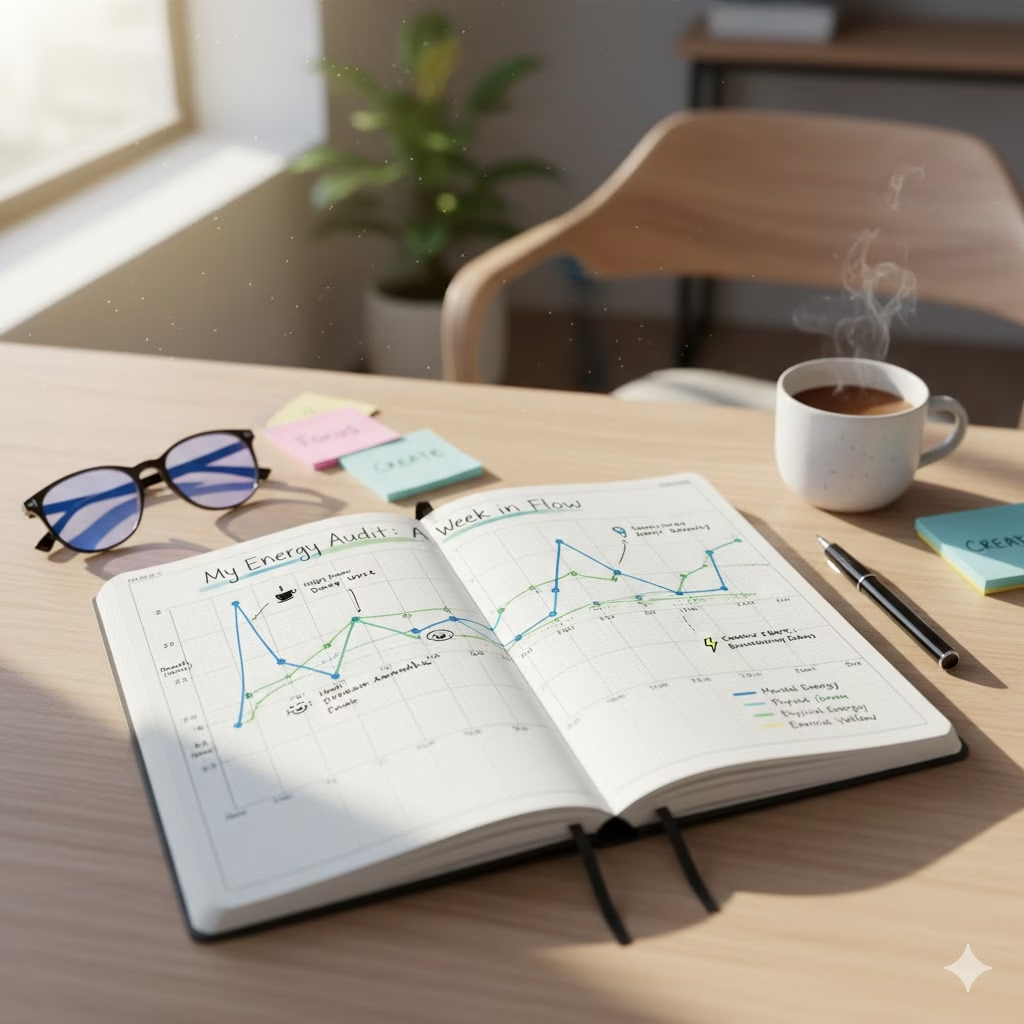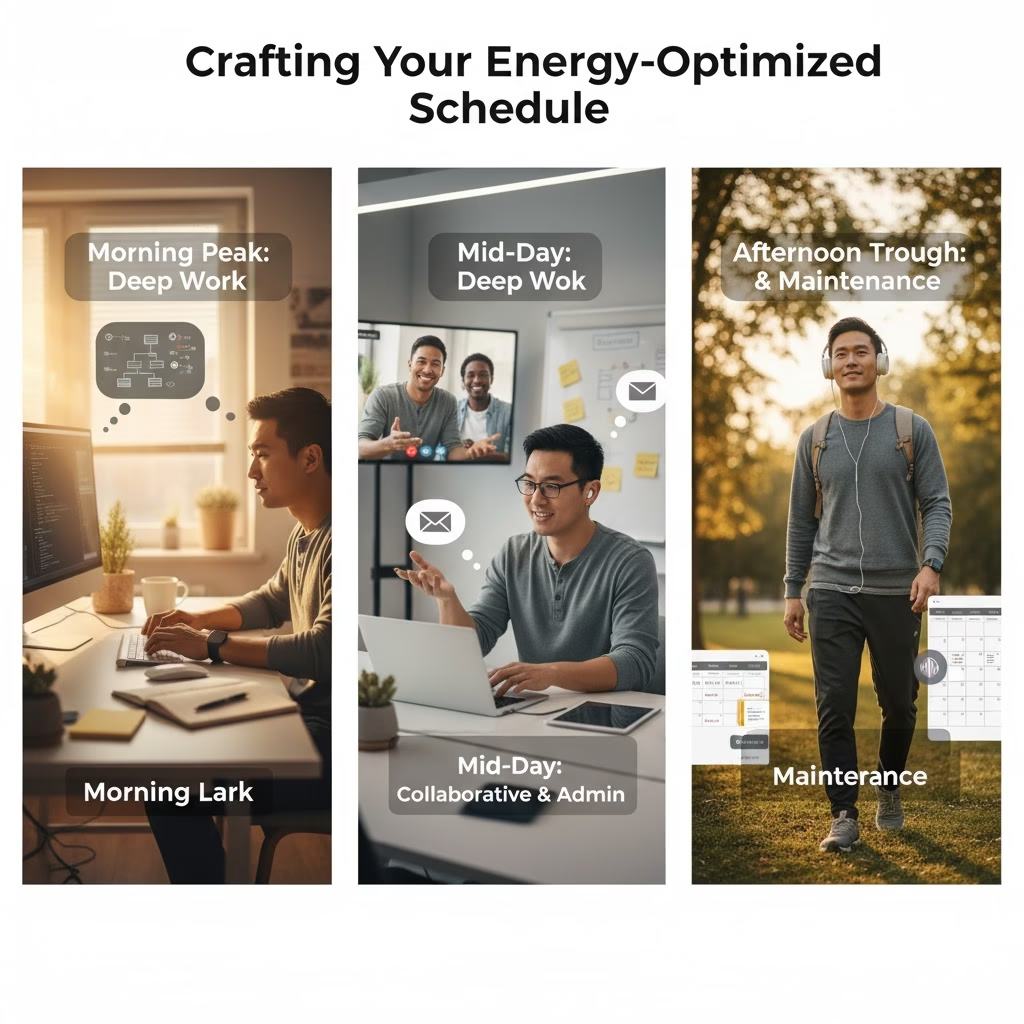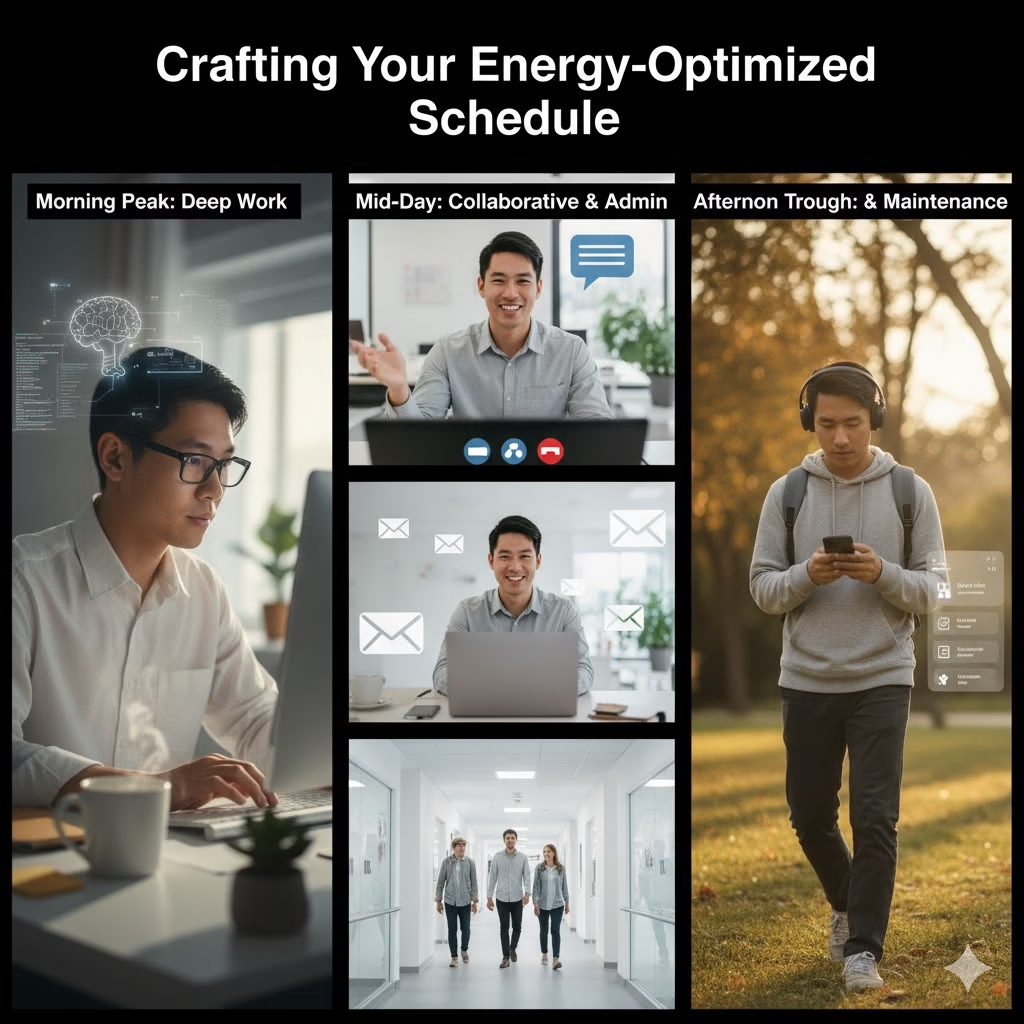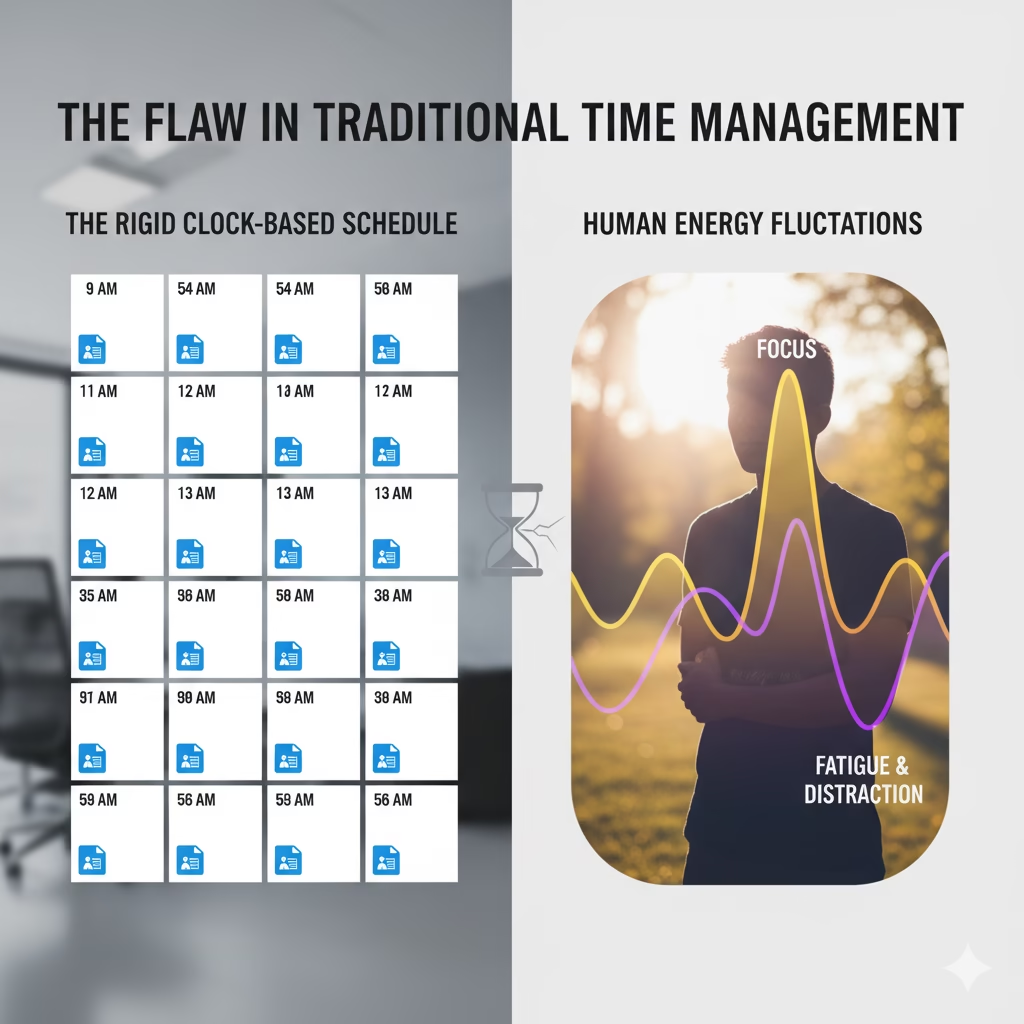
Do you feel constantly burnt out or like you’re always falling behind on your to-do list? It’s frustrating when you put in the hours but still feel exhausted. We often approach daily scheduling rigidly without thinking about our natural energy. This article offers a refreshingly human-centered approach to time management that can truly transform how you work and how you feel.
Time Management: Scheduling by Energy, Not Just the Clock

Most of us chase productivity with endless to-do lists and strict schedules. We work hard, check off tasks, and then wonder why we feel drained, unmotivated, and always behind. What if the basic rules of time management are flawed? What if the key to real, long-lasting productivity isn’t working harder, but working smarter? We can do this by matching our tasks to our body’s natural energy flow.
This is the core of energy-based scheduling. It is a major change from just following the clock. It focuses on the rise and fall of your personal energy. This strategy promises not just more finished work, but also less stress and a renewed sense of purpose.
Why Traditional Time Planning Fails Us
For years, managing time has meant being efficient. It has meant breaking down tasks and fitting them into specific blocks of time. The big problem with this approach is the hidden assumption: it assumes your energy and focus are the same every hour of the day. As anyone who has struggled to focus after lunch knows, this is not true.
We are not machines. Our energy levels change naturally throughout the day. These changes are controlled by our body clock (circadian rhythms), how well we sleep, what we eat, our stress levels, and even our chronotype (if we are a morning person or a night person). Trying to force yourself to do a hard, focused task during a natural energy dip is useless. It drains you quickly and doesn’t get results.
Getting to Know Your Energy

The first step in energy-based scheduling is to closely watch your own internal state. Most of us are too busy with daily life to pay attention to this.
What Does “Energy” Mean Here?
When we talk about energy, we mean more than just being physically active. We include:
- Physical Energy: Your body’s capacity to move and sustain effort.
- Mental Energy (Focus): Your ability to concentrate, solve problems, and do deep work.
- Emotional Energy: Your capacity to handle feelings, talk with others, and stay positive.
- Creative Energy: Your ability to brainstorm new ideas and think outside the box.
These types of energy peak and dip at different times, though they often affect each other.
Chronotypes: Lark, Owl, or Hummingbird?
One of the biggest factors that shapes your energy is your chronotype. Understanding yours is essential:
- Morning Larks: Feel their best energy early in the day (6 AM – 12 PM). They often get tired by evening.
- Night Owls: Feel their best energy later in the day (3 PM – 9 PM or later). They find early mornings difficult.
- Hummingbirds (or Third Birds): The largest group. They adapt well but still have clear times of high and low energy.
Knowing your chronotype helps you understand your inborn energy flow.
How to Do Your Personal Energy Check
Before you can schedule by energy, you need facts. You need to observe yourself objectively.
Step 1: Track Your Energy for One or Two Weeks
- The Tool: A simple notebook, a digital journal, or a basic spreadsheet.
- The Method: For 7 to 14 days, write down a note every 2 to 3 hours (e.g., 9 AM, 11 AM, 1 PM, 3 PM, 5 PM).
- What to Track: Rate your mental focus (1-5, 5 being sharpest), physical energy (1-5, 5 being most energetic), and your mood/drive (1-5, 5 being highly motivated). Also, note what you were doing and any key outside factors (e.g., “just had coffee,” “heavy lunch,” “stressful call”).

Step 2: Find Your Highs, Lows, and Rest Times
After tracking, review the data. Look for clear patterns:
- Peak Energy Zones: When are you reliably most alert and focused? These are your “power hours.” For many Larks, this is mid-morning. Owls often find this in the late afternoon or evening.
- Low Energy Troughs: When do you usually feel slow, distracted, or foggy? This is a common time for the mid-afternoon slump.
- Recovery Zones: Are there times when a short break, a quick walk, or light activity makes your energy bounce back significantly?
Example of an Energy Check Discovery:
- Scenario: Mark tracks his energy. He sees that his focus is high (4 or 5) from 9 AM to 12 PM. From 1 PM to 3 PM, it drops to a 2 or 3, making him feel sleepy. In the late afternoon (3 PM – 5 PM), he gets a second burst of energy, reaching a 3 or 4, especially for creative tasks.
- Insight: Mark learns his best strategic work should happen in the morning. His post-lunch slump is real, and his creative ideas flow later in the day.
Building Your Energy-Based Schedule: The Practical Steps
Now that you know your energy map, it’s time to rebuild your schedule. This is not about squeezing more into your day; it’s about fitting the right things into the right times.
Rule 1: Match Tasks to Your Energy Highs
This is the most important rule. Group your tasks by the type of energy they need:
- High-Focus/Deep Work (Peak Energy): Planning, writing long reports, solving hard problems, coding, generating creative ideas, learning. These need your best mental effort.
- Medium-Focus/Group Work (Mid-Energy): Meetings, answering emails, working with others, simple admin tasks. These need attention but not intense solo focus.
- Low-Focus/Maintenance Work (Low Energy/Troughs): Data entry, routine paperwork, organizing files, setting appointments, light exercise, preparing food. You can do these when your brain is naturally resting.
Putting it to Use:
- Morning Lark: Put deep work (like planning or writing) from 9 AM to 12 PM. Use early afternoon for emails and meetings. Save late afternoon for easy administrative tasks or walking.
- Night Owl: Use the morning for lighter tasks (like checking emails). Schedule your most important deep work for the late afternoon or evening, when your focus is naturally highest.
Rule 2: Plan Smart Breaks and Transitions

Breaks are not just time off; they are vital for recharging your energy.
- Micro-Breaks: Take short (5-10 minute) breaks often, especially during focused work. Stand up, stretch, look away from the screen.
- Mid-Day Recharge: Use your lowest energy times for real breaks. This might be lunch, a walk, a few minutes of quiet, or a power nap if possible. Don’t fight the slump—use it to rest.
- Transition Time: Add short buffers between different kinds of tasks. This helps your brain switch focus without feeling hurried.
Example: Beating the Mid-Afternoon Slump
- If you know you get foggy at 2 PM, don’t try to force yourself to do hard analysis. Instead, schedule a 15-minute walk outside, listen to an energizing podcast, or handle light administrative duties. This helps your focus come back later.
Rule 3: Guard Your Peak Productivity Time
Once you find your highest energy times, protect them strictly.
- Block Your Time: Use your calendar to block out “Deep Work” or “Focus Time.” Treat these blocks like must-attend meetings.
- Stop Distractions: Turn off notifications, close distracting websites, and clearly tell colleagues you are unavailable during this time.
- Learn to Say No: Politely decline meetings or requests that try to invade your peak time. Suggest other times when your energy is better suited for group work.
Rule 4: Stay Flexible and Adapt Often
Energy-based scheduling is not about creating a rigid, unbending plan. It’s about having a flexible structure.
- Be Ready for Change: Some days you won’t sleep well, or unexpected tasks will pop up. Be ready to adjust. The goal is good alignment most of the time, not perfection all the time.
- Re-Check: Your energy can change because of stress, lifestyle changes, or even the seasons. Re-do your energy check every few months to be sure your scheduling is still optimal.
Energy-Based Scheduling Examples

Let’s see how this works for different people.
Example 1: The Creative Freelancer
- Chronotype: Night Owl
- Energy Check Result: Low morning energy, strong peak late afternoon/evening, best creative ideas after 4 PM.
- Schedule Plan:
- 9 AM – 12 PM: Light administration, checking emails, reading industry news, gentle work.
- 12 PM – 1 PM: Lunch break and a short walk.
- 1 PM – 4 PM: Client calls, team check-ins, tasks that need talking but not deep, solo focus.
- 4 PM – 8 PM: Peak Creative Work. This is when product design, writing long articles, or strategic brainstorming happens. This is the flow state.
- 8 PM onwards: Relax and personal time.
Example 2: The Project Manager

- Chronotype: Morning Lark
- Energy Check Result: High focus from 9 AM to 1 PM, a big dip from 1 PM to 3 PM, good recovery for interacting with people from 3 PM to 5 PM.
- Schedule Plan:
- 9 AM – 12 PM: Peak Strategic Work. Project planning, budget reviews, writing critical reports. Office door closed, no interruptions.
- 12 PM – 1 PM: Lunch break and a brisk walk to reset.
- 1 PM – 3 PM: Energy low. Schedule routine tasks like processing invoices, answering non-urgent emails, or light administrative duties.
- 3 PM – 5 PM: Meetings, team check-ins, client calls. Energy is fine for group work.
- 5 PM onwards: Quickly prepare next day’s to-do list, then finish work.
Example 3: The Student Who Works Part-Time

- Chronotype: Hummingbird who focuses best in the evening.
- Energy Check Result: Good morning energy for easy tasks, dip after lunch, strong focus for difficult subjects late afternoon/early evening.
- Schedule Plan:
- 9 AM – 1 PM: Attend classes (if scheduled), review notes, light reading, administrative tasks for the job, easy chores.
- 1 PM – 2 PM: Lunch and a brief rest.
- 2 PM – 4 PM: Part-time job hours or group study sessions (uses social energy, not intense focus).
- 4 PM – 8 PM: Peak Study Time. Work on hard assignments, thesis writing, or complex projects.
- 8 PM onwards: Relax, socialize, and prepare for sleep.
Dealing with Common Problems

While this approach is helpful, following it is not always easy, especially in a traditional workplace.
1. Fixed Work Hours and Meetings
- Strategy: Try to influence what kind of work you do during fixed times. If a meeting happens during your energy low, use that time mostly for listening. Save your active input for when you feel sharper. Use your limited flexible time wisely.
- Use Your Freedom: Even if your main work hours are fixed, how you structure your time around them—your start, end, and lunch—is important.
2. Urgent Demands
- Strategy: Not every task can wait for your peak time. Real emergencies must be handled. However, this method often reduces emergencies because you stay ahead of your most important work during your peak hours.
- Prioritize: Tell the difference between urgent and important. Urgent tasks often pop up because important tasks were delayed.
3. Manager Expectations
- Strategy: Talk about the results. Explain that you are aiming for better quality work and sustained output. Share why you are optimizing your scheduling. Frame it as boosting your value and contribution.
More Than Productivity: Better Well-being
The benefits of scheduling by energy go far beyond just finishing more tasks.
- Less Burnout: By respecting your natural body clock, you prevent constant energy loss. You work with your body, not against it.
- Higher Job Satisfaction: When you do tasks in your optimal mental state, you feel more successful and less stressed.
- Better Work-Life Balance: Being more efficient during work hours means you have more genuine free time and mental space outside of work.
- Higher Quality Work: Focused attention during peak periods leads to better results and fewer errors.
Conclusion: Take Back Your Day, Recharge Your Life

“Time Management: Scheduling by Energy, Not Just the Clock” is more than a simple trick; it’s a way of life. It recognizes that humans are not machines. Our most valuable resource is not time itself, but our energy. By understanding, respecting, and smartly aligning with your natural energy patterns, you can change how you feel about work. You will boost your productivity and create a more sustainable, fulfilling life. Start your energy check today, and take the first step toward a more energized, effective, and empowered you.
Frequently Asked Questions (FAQ)
Q1: How long does it take to figure out my energy patterns? A1: You should track your energy for at least one week consistently. Two weeks is even better, as it gives more reliable data and accounts for daily changes.
Q2: What if my work schedule is very rigid and offers little flexibility? A2: Even with a rigid schedule, you can use this concept. Focus on scheduling the type of task you do within your fixed blocks. For example, use a guaranteed quiet hour for deep work. Use times when you expect to be interrupted for easier tasks like checking emails. Also, make your breaks count for recovery.
Q3: My energy levels feel consistently low. What should I do? A3: If your energy is always low, you must look at basic lifestyle factors first. Ensure you are getting enough sleep, eating well, drinking enough water, and managing stress. Exercise can also greatly boost energy. If the problem continues, please see a doctor.
Q4: Can this approach help me stop procrastinating? A4: Yes! Procrastination often happens because you dread the effort a task will take, especially if you try to do it when you’re tired. By scheduling tough tasks for your peak energy times, you make it easier to start and finish them.
Q5: How do I handle unexpected urgent tasks that disrupt my schedule? A5: While a perfect schedule is the goal, life is often unpredictable. Handle true emergencies, but then return to your schedule as quickly as you can. See these as small bumps, not a reason to quit the system. This smart scheduling should actually lead to fewer urgent tasks over time.
Q6: Does my chronotype control my energy, or can I change it? A6: Your chronotype is mostly determined by genetics—you cannot completely change whether you are a morning or night person. However, you can learn to work with your chronotype and optimize your schedule to use your natural peak times instead of fighting them.
Q7: How can I convince my manager or team to adopt energy-based scheduling? A7: Start with yourself. Show them the results: your higher productivity and less stress. Share articles and ideas. Suggest a small trial, like having a “no meeting morning” for the team’s focused work. Frame it as a way to improve team efficiency and prevent burnout.
References
- HBR – Productivity Skills to Help You Gain Time Back
- State.gov – Why Time Management?
REcent Posts


